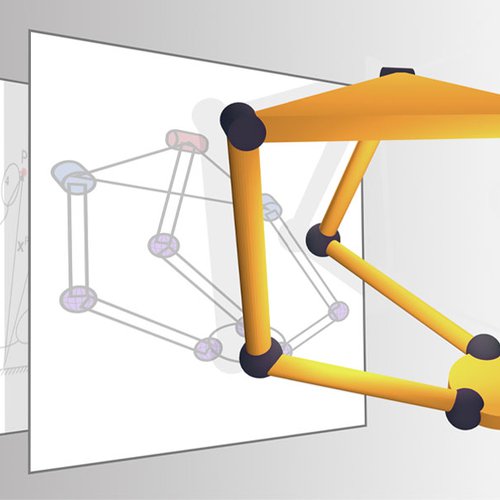Modeling and Simulation of Multibody Systems 2
- Durée : 14 semaines
- Effort : 140 heures
- Rythme : ~10 heures/semaine
90% of daily life multibody systems contain loops of bodies, e.g. vehicle or bike suspensions, parallel manipulators or robots, and musculoskeletal systems. They can also include joint constraints. In this second course about multibody systems, learn how to model them and how to deal with more advanced numerical analyses.
This course is provided in collaboration with UCLouvain (Université catholique de Louvain) on edX.
Click on Enroll Now to sign up on edX.org.
Prerequisites:
Part 1: MOOC in “Modeling and simulation of multibody systems – Part I” (Louv25X.1x); or equivalent
Description
This course aims at acquainting you with the modeling and simulation of constrained multibody systems, and especially mechanical systems with kinematic loops, such as real vehicle or bicycle suspensions, parallel manipulators or robots, musculoskeletal systems, etc.
You will also learn to deal with more advanced numerical analyses:
- Direct kinematics;
- Inverse kinematics;
- Equilibrium;
- Modal analysis;
- Direct Dynamics;
- Inverse Dynamics.
This course is based on (1) video clips focusing on the main theoretical background and concepts, (2) well-illustrated written sections given more details about the mathematical formulation, and (3) questions, exercises and modeling projects.
Despite the intrinsic complexity of such systems in terms of morphology and motions, basic skills in Newtonian mechanics, linear algebra and numerical methods are sufficient to model them, provided that the endless and tedious computation related to their internal kinematics and dynamics are at our disposal. This is the purpose of the symbolic program ROBOTRAN, which can be used with this course and can automatically generate the full set of equations of motion of a constrained MBS, in a symbolic manner, i.e. exactly as if you were writing them by hand, whatever the size and their morphological complexity of the application. Hence, this course will instead teach you how to intervene upstream and downstream this generation step.
Upstream the latter, you will learn how to translate a real system, e.g. a car suspension, into a virtual multibody model comprising algebraic constraints between joints, kinematic loops, etc.
Downstream the symbolic generation, your intervention will consist in:
• Completing the symbolic model with features that are specific for your system, e.g. a tire force model or the tuning of a motion controller, among other things;
• Selecting and implementing under the form of a program (in Python, Matlab, or C) the suitable numerical method to solve the differential equations of motion, given the original question; (1) an equilibrium solution can give you the static forces and the system deflection, (2) a time simulation can compute any transient motion of the system submitted to forces and torques, (3) a modal analysis will provide you with the eigenmodes that inform you about the system stability and damping characteristics, (4) an inverse dynamics study can provide you with the necessary forces and torques for any prescribed motion of the system, (5) etc.
• Selecting the most suitable results, including self-explanatory - and sometimes funny - video animations of your multibody system in motion.
In sum, this course, based on the use of the ROBOTRAN* symbolic generator, will allow you to focus on the most interesting aspects of the multibody modeling process, by entirely mastering your computer model from the input data to the results, instead of using a black-box multibody program that clearly goes against the educational objective of such a course.
Enjoy Multibody Dynamics!
What You'll learn
In this course devoted to constrained multibody systems, you will learn how to:
• translate a real constrained mechanical system in the light of the issue to solve, into a multibody model;
• complete your model with features and sub-models that are specific to your application;
• build and master a program (in Python, Matlab or C) to select the appropriate numerical analysis, simulate the system and produce the expected results.
*Note: The course was built to teach modeling and simulation of multibody systems, and not to teach any specific software. However, we suggest that you use the symbolic ROBOTRAN program to model and study the various multibody systems proposed in this course.
Sessions de cours
Archivé
- Modeling dans Simulation of Multibody Systems 2, inscription du 1 novembre 2021 au 9 mai 2022
Équipe pédagogique
Raison, Maxime
Catégories
Maxime Raison a obtenu son diplôme en génie électrique et son doctorat en génie mécanique de l’UCLouvain. Il est professeur titulaire en génie mécanique et biomédical à Polytechnique Montréal, où il enseigne la mesure dynamique et la modélisation ainsi que le génie de la réadaptation. Il est directeur de la Chaire de recherche en génie de la réadaptation pédiatrique, au Technopôle du Centre hospitalier universitaire CRME-Sainte-Justine, à Montréal. Ses principaux sujets de recherche sont la modélisation dynamique multicorps, la robotique d’assistance et l’intelligence artificielle en génie biomédical.
Fisette, Paul
Catégories




